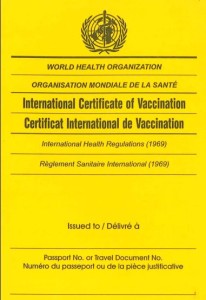Yellow fever is a viral and dangerous disease transmitted by mosquitos of the Aedes, Haemagogus or Sabethes family. Diagnosis, especially at the early stages can be confused with other viruses as malaria, dengue, viral hepatitis or other diseases as well as poisoning. Blood test can detect fever antibodies, tests require specialised equipment and staff.
Transsmissions can regard people working in the jungle – infected mosquitos that feed on monkeys infect humans, semi-domestic mosquitos that breed in the wild and around households infect monkeys and people. That outbreak is common type in Africa. The third one – urban means that epidemics occur when infected people introduce the virus into a populated area with high number of non-immune people.
The virus incubates for 3 to 6 days and is followed by infection. The first phase usually causes fever, muscle pain with backache, headache, shivers, loss of appetite, and nausea or vomiting. Most patients improve after that and the symptoms disappear after several days. Nonetheless – about 15% of patients enter a second, toxic phase within 24 hours of the initial remission. There is again high fever and body systems gets affected. Such patients develop jaundice very quickly. They complain of abdominal pain and vomit. There might be bleeding from the mouth, nose, eyes or stomach, then blood appears in the vomit and faeces. There is malfunction of kidneys. Important: half of the patients who enter the toxic phase die within 10 to 14 days, the rest recover without significant organ damage. It is a dangerous disease and cannot be underestimated. There is no specific treatment – only supportive care to dehydration, respiratory failure and fever. Antibiotics are used to treat associated bacterial infections.
Vaccine – it is safe for children over 9 months, quite affordable and single dose can provide life-long immunity against the disease. Sometimes a booster dose is needed after 10 years. They are noted by a physician in the so called “Yellow book”. If you plan travelling to Africa or via Africa do vaccine yourself. It is required as well in some parts of Americas.
STAMARIL – produced by Sanofi Pasteur – price ca. 50€

An outbreak of disease was detected in Angola at the end of 2015. It spread quite significantly through the country with an alert situation now, in May with over 2400 suspected cases. There has been consequently confirmed cases in other countries in connection to Angola. Democratic Republic of Congo – almost 50 laboratory confirmed cases, 60 suspect cases in Uganda. Risk in Angola is still high, despite a large number of vaccinated people, especially in areas hard to reach and highly populated. Due to crossborder economic and social activities yellow fever with connection to Angola was confirmed in Kenya and China.
This outbreak has even raised concerns about the global supply and its adequacy in case of large epidemic. There has been about 10 million doses diverted to Angola between March and May 2016 of emergency stockpiles. The general demand for preventive campaigns increased from ca. 5 million per year to over 60 million per year. Production of the vaccine is at the level of 35 million per year.
Sources: http://apps.who.int/iris/bitstream/10665/206548/1/yellowfeversitrep_20May2016_eng.pdf?ua=1
https://www.medicines.org.uk/emc/medicine/9846










